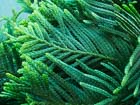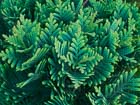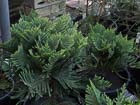
Tree in habitat; one of the photos posted on the endemia.nc page for L. chevalieri [Rémy Amice 2005.11.02].

Foliage on a sapling at the Royal Tasmanian Botanical Gardens [C.J. Earle, 2015.02.25].

Foliage on a sapling at the Royal Tasmanian Botanical Gardens [C.J. Earle, 2015.02.25].

Foliage on two small saplings at the Royal Tasmanian Botanical Gardens [C.J. Earle, 2015.02.25].

A portion of the isotype, collected 1947.12.28 by J.T. Buchholz, showing fertile twigs bearing female cones. Note the bract-scale complexes (the seed cones) and the spiny free tips of the scales. The size of the cones and length of the spines are important characters in identificaton of Libocedrus species, as are the morphology of the facial and lateral leaves.

Conservation Status

Libocedrus chevalieri
Buchholz 1949
Common names
Taxonomic notes
Syn.: Stegocedrus chevalieri (J.T. Buchholz) Doweld 2001. Type: New Caledonia, Mont Humboldt, J.T. Buchholz 1567. Few studies have been performed on Libocedrus, but work to date suggests that the New Caledonian species are all closely related; see Libocedrus for discussion.
Description
A shrub or small tree to 5 m tall, usually with several stems branching near the base, with numerous ascending branches forming a dense, often rounded crown. Bark brown, scaly, peeling in irregular strips or plates. Twigs arranged on the branches in frond-like sprays, the twigs alternate to subopposite, flattened (juvenile) to 4-angled (adult) in cross-section, 3-4 mm across, entirely covered with leaves. Facial and lateral leaves very different in juvenile leaves, but very similar in adult leaves. In juveniles, laterals are much larger (2.5-5 mm long) than facials, acute; in adults, all leaves 2-3 mm long, blunt, touching the base of the next leaf along the twig. Facial leaves keeled. Pollen cones terminal, solitary, 8-10 × 2.5-3.5 mm with 16-24 microsporophylls. Seed cones 10-12 mm long, the spiny free tips of the bracts 6-7 mm long. Seeds about 6 mm long with a 12 mm wing (Eckenwalder 2000, Farjon 2010).
Distribution and Ecology
New Caledonia: there are only 3 known populations: in the S, at Mt Humboldt and Mt. Kouakoue; in the N, at Poindimie. Grows at 650-1,620 m elevation, which is near the highest summits, usually in maquis near the contact zones between schists and serpentines. Precipitation is high (ca. 4,000 mm/yr) but due to high runoff and thin soils, drought does occur. The northernmost population has no protected status. Growth is slow, regeneration uncommon, and fire is a risk, factors that contribute to the "critically endangered" conservation status (Eckenwalder 2000, Farjon 2010).
This map shows herbarium records of Libocedrus species native to New Caledonia. Red is L. austrocaledonica, yellow is L. chevalieri, and green is L. yateensis. Click on an icon for further information. Distribution data from GBIF (2020.03.30), edited to remove duplicates.
Zone 10 (cold hardiness limit between -1°C and +4.4°C) (Bannister and Neuner 2001).
Remarkable Specimens
No data as of 2023.03.03.
Ethnobotany
No known use by indigenous peoples, no known use in horticulture, and very uncommon in botanical gardens (Farjon 2010).
Observations
Remarks
The epithet recalls L. Chevalier, conservator of the New Caledonia museum in Noumea (Buchholz 1949) and a plant collector in New Caledonia in the 1940s and 1950s (Farjon 2010). A bit of the flavor of plant-collecting in New Caledonia can be gleaned when Buchholz relates "Mr. Chevalier was leader of an expédition to Mt. Humboldt which I organized and promoted in Dec. 1947. In company with two natives Marengo and Victor of Tribu Bangou as guides, he and my helper Moenadji, a Javanese, reached the summit of Mt. Humboldt on December 27-28, 1947 in a successful approach from Mt. Vulcain. This trail made across very rugged ridges has no springs and required 28 liters of water carried over a 20 km. trail to a campsite at 1.300 m. on a 2 day trip. While others had previously climbed Mt. Humboldt from the west by two different routes, this was the first successful ascent using a trail from the end of the road to 600 m. at mine Gallini on Mt. Vulcain."
Citations
Buchholz, J. T. 1949. Additions to the coniferous flora of New Caledonia. Bull. Mus. Natl. Hist. Nat. (Paris), Sér. 2, 21(2):279–286. Available: Biodiversity Heritage Library, accessed 2020.02.10.
See also
Association Endemia, a site devoted to New Caledonian species. Has excellent photos, a range map, and other information. In French.
The species account at Threatened Conifers of the World.
Farjon (2005) provides a detailed account, with illustrations.





